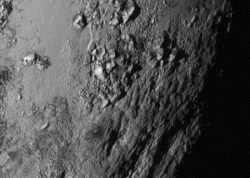|
 Tiny
Pluto sports big mountains, New Horizons finds Tiny
Pluto sports big mountains, New Horizons finds
 Send a link to a friend
Send a link to a friend
[July 16, 2015]
By Irene Klotz
LAUREL, Md. (Reuters) - The first close-up
views of Pluto show mountains made of ice and a surprisingly young,
crater-free surface, scientists with NASA's New Horizons mission said on
Wednesday.
|
|
 The results are the first since the piano-sized spacecraft capped
a 3 billion mile (4.82 billion km), 9-1/2-year-long journey to pass
within 7,800 miles (12,550 km) of Pluto on Tuesday. The results are the first since the piano-sized spacecraft capped
a 3 billion mile (4.82 billion km), 9-1/2-year-long journey to pass
within 7,800 miles (12,550 km) of Pluto on Tuesday.
New Horizons is now heading deeper into the Kuiper Belt, a region of
the solar system beyond Neptune that is filled with thousands of
Pluto-like ice-and-rock worlds believed to be remnants from the
formation of the solar system, some 4.6 billion years ago.
Scientists do not know how Pluto formed such big mountains, the
tallest of which juts almost 11,000 feet (3,350 meters) off the
ground, nearly as high as the Canadian Rockies.
Another puzzle is why Pluto has such a young face. The icy body,
which is smaller than Earth's moon, should be pocked with impact
craters, the result of Kuiper Belt rocks and boulders raining down
over the eons.

Instead, New Horizons revealed that the surface of Pluto has somehow
been refreshed, activity that may be tied to an underground ocean,
ice volcanoes or other geologic phenomenon that gives off heat.
Scientists believe Pluto's mountains likely formed within the last
100 million years, a relative blink compared to the age of the solar
system.
New Horizon's first close-up, which covered a patch of ground about
150 miles (241 km) near Pluto's rugged equatorial region, even has
scientists wondering if the icy world is still geologically active.
"Pluto has so much diversity. We're seeing so many different
features ... there’s nothing like it," New Horizons scientist Cathy
Olkin told reporters at Johns Hopkins University Applied Physics Lab
where the mission control center is located.
[to top of second column] |

Another surprise was Pluto's primary moon, Charon, which was
believed to be geologically dead. Instead, New Horizons found
troughs, cliffs and giant canyons - all evidence of internal
processes.
"Charon just blew our socks off," said Olkin.
So far only a fraction of the thousands of pictures and science
measurements collected by New Horizons during its traverse through
the Pluto system have been relayed. The data will be transmitted
back to Earth over the next 16 months.
"I don't think any one of us could have imagined that it was this
good of a toy store," said New Horizons' lead scientist Alan Stern.
(The story was refiled to correct the name of the lab in the ninth
paragraph)
(irene.klotz@thomsonreuters.com)
[© 2015 Thomson Reuters. All rights
reserved.]
Copyright 2015 Reuters. All rights reserved. This material may not be published,
broadcast, rewritten or redistributed.

 |